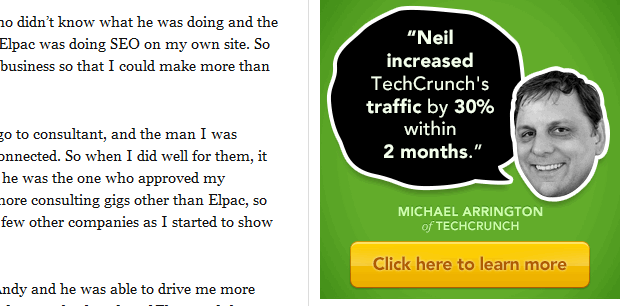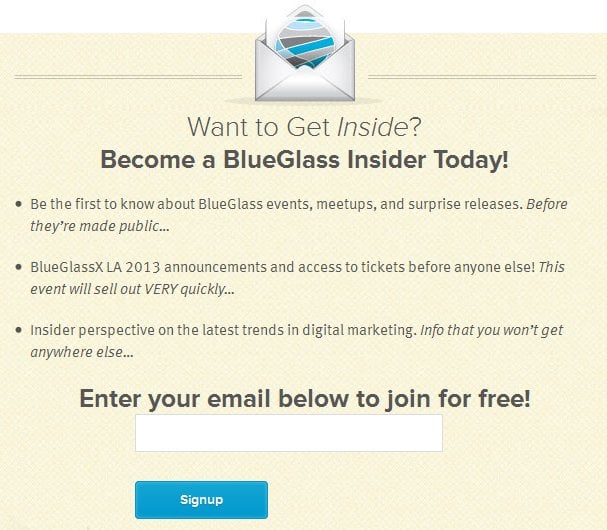
Creating Conversion Out of Content
This YouMoz entry was submitted by one of our community members. The author’s views are entirely their own (excluding an unlikely case of hypnosis) and may not reflect the views of Moz.

In a recent post on the Ascent Internet blog, I laid out the case for compelling Web content from a marketing standpoint. However, having targeted, high quality content is not enough for a website - you need tools to capture the users of your content.
It has been said that content is king on the Web but converting users to buyers or qualified prospects that you can continue to retarget is usually a website's goal.
Before crafting calls to action, it's important to understand the customer mindset and what will make them more likely to respond. What potential customers really want to know is, "What's in it for me?" You need to identify user's hot buttons and incorporate that into your marketing (source). When crafting calls to action, the proper message is important. What types of message are more likely to prompt/nudge people to take action? There is a whole science behind the art of persuasion.
Below are ten ways to reach more customers with your content:
1. Prominent Calls to Action.
Focused, prominent calls to action are critical for any commercial website. To an extent, arranging Web content should be similar to how newspapers design their pages. Focus on the ads first and then fit the content around what converts. This is a primary reason why visually impressive design on a site is important, allowing for better conversion.
In addition to design, calls to action also show the value of Web programming. Typically, calls to action may be in the header, sidebar, or end/footer of the content. But sometimes you need to get creative and use smart techniques.
For example, notice how on Neil Patel's Quick Sprout blog, that when you scroll down, the case study from Tech Crunch at the bottom of the right sidebar remains in place no matter how far down you scroll the page. It is a good general rule to never have a portion of your content free from a prominent, compelling call to action.

However, promoting services is a balancing act. You want your content to provide value to the user without overwhelming them with other messages or services they may not want. But at the same time, you want to convert them into a paying customer.
2. Pop-Ups.
Pop-ups on a website have been historically much reviled and many browsers block pop-ups but there are workarounds. While they can be an annoyance, studies and numbers bear out that pop-ups are effective and for websites using content marketing, they are likely to convert more customers than websites that don't.
Pop-ups don't have to be overly intrusive. You can put pop-ups on a timer so that they only appear after the user has had a chance to make use of the content for a period of time from the Website. An example I like is from Inc. Magazine's website, which has a pop-up that only appears in the bottom left portion of an article once you start scrolling down the page. Inc.'s website also uses more intrusive full screen pop-ups.

3. Case Studies.
Prospective customers may be hesitant. Before they part with their hard-earned money for a service, they want to see a proven track record of results. That is why case studies with stories of how a company's services have benefited others can make such a big difference.
In your case studies, tell a story and use visuals or videos to enhance. Compelling case studies can even be quite sharable on social networks and link worthy, which helps SEO.
4. Testimonials.
Testimonials are similar to case studies, but much shorter. This is where implementing processes and procedures to capture customers' testimonials pays off. In addition to capturing testimonials on your site, businesses should also promote and encourage customers to leave reviews on their Google+ page and other websites such as Yahoo Local, Yelp, Judy's Book, and Angie's List.
Make it easy for your fans to have their voice heard and support you.
5. Email Sign Up.
Since 95% of your website's visitors won't be ready to buy on their first visit, capturing their information to retarget them can really move the needle on sales in the long run. And as Rand so astutely lays out in this Slideshare presentation below, people need a nudge.
Website visitors may be interested in receiving more information and new content via email. This is where the value of an email sign up form comes in to capture contact information and continue to market to them.
Email sign up forms are ubiquitous in the sidebar of blogs and they can also appear as pop-ups. But there are more creative and effective ways of going about getting subscribers. Blue Glass does a good job on their blog of inviting and making the case for users to sign up for their email list to become a Blue Glass "Insider".

6. Feature Contests/Promotions.
Holding contests and giving away prizes can be a great way to keep visitors coming back and convert them into customers. Giveaways and prizes can also be used to drive traffic and keep sales more steady throughout the year. Facebook is a popular medium to hold contests and drive engagement, but there are strict guidelines to follow.
7. Promote Your Social Networks.
 Having a strong following on social networks is an important component of the marketing funnel. Social following helps awareness, branding, and promotes trust. Use your website content, contests, and promotions to gain more likes and more social media followers on your networks including Facebook, Twitter, Google+, LinkedIn, Pinterest, and YouTube.
Having a strong following on social networks is an important component of the marketing funnel. Social following helps awareness, branding, and promotes trust. Use your website content, contests, and promotions to gain more likes and more social media followers on your networks including Facebook, Twitter, Google+, LinkedIn, Pinterest, and YouTube.
Even if new social media followers aren't buyers, they can still help augment your social following and some may become brand evangelists helping to spread the word on your product or service. Also, search engines are increasingly using social signals as a component of the SERPs.
8. Trust Badges.
Establishing trust on the Internet is important. People may not have physically been to your business or talked to or met a representative of the company. And there are still too many online scams and people who have been burned with a bad Web experience.& This is where having badges that display trust can help.

In fact, trust badges are big business with companies like Verisign, Comodo, and McAfee and organizations like the BBB generating a lot of income, in part, from the value of their badge. These badges are symbols of trust and can help users feel more assured and make a purchase.
If you are on a budget, social media buttons can serve as trust badges. It shows community, engagement, and a real business doing real things.
9. Easy Contact Form.
Having a contact form or prompt for customers to ask questions and get help is another important element that should be highly visible on a business' Web page. Using a live chat service such as Olark, Zopim, or NGage can help you capture more customers.
10. Prominently Display Phone Number.
This may go without saying but as a recent Andrew Shotland column pointed out, not enough small-medium sized businesses are doing this. A business' number should be displayed prominently on each Web page's header and below the content as well.
Conclusion
Compelling, targeted content should be used as a catalyst that sparks a website visitor's interest. But with all the focus on the quality and volume of content, too many are overlooking the business goals of capturing leads and garnering more sales. Instead of focusing on publishing content for search engine rankings or getting links to content, are you doing enough to make it convert and turn visitors into customers?
Create linkable content wrapped in a website aimed at conversion. After all, this is marketing and sales should be the primary goal.







Comments
Please keep your comments TAGFEE by following the community etiquette
Comments are closed. Got a burning question? Head to our Q&A section to start a new conversation.